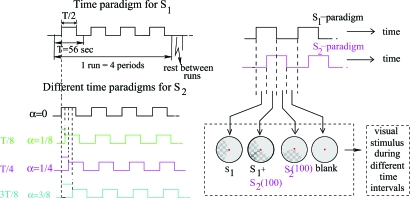Fig. 6.
(Left) Temporal paradigm. (Upper) Time paradigm for visual stimulus S1. (Lower) Time paradigms for S2, for different α. For α = 0 (not used in experimental runs), the paradigm is just that of S1; for α = 1/8,1/4,3/8, respectively, it is shifted by αT. (T = 56 sec. = period of the time paradigm.) (Right) Combined paradigm for (α,θ) = (1/4,100): wedge S2(100) is turned on and off according to the time paradigm shifted by T/4.

